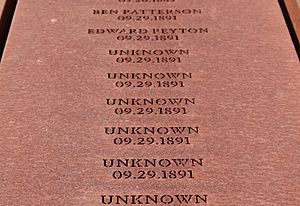Cotton pickers' strike of 1891 facts for kids

The cotton pickers' strike of 1891 was a protest by African-American sharecroppers in Lee County, Arkansas. It happened in September 1891. This strike led to serious conflicts between the workers and plantation owners. There was also violence, and a group of lawmen (a sheriff's posse) and a mob (a lynching party) were involved. During these events, one plantation manager, two workers who were not striking, and about twelve striking workers lost their lives. Nine of the striking workers were killed by a mob on the evening of September 29.
Why the Strike Happened
In 1886, a group called the Colored Farmers' National Alliance and Cooperative Union was started. It was founded by R.M. Humphrey, a white Baptist minister. He was also part of a similar group for white farmers called the Farmers' Alliance.
In early September 1891, Humphrey asked African-American sharecroppers across the country to go on strike. This was because plantation owners had decided to pay only 50 cents for every 100 pounds of cotton picked. Humphrey wanted the workers to demand $1 for every 100 pounds.
Even though Humphrey said millions of members would strike, the national strike planned for September 12 did not happen anywhere else. Many landowners also tried to stop the strike by having more police around or by offering small pay raises. Newspapers in the South were happy that the strike failed.
However, there was one place where the strike did take hold: Lee County, Arkansas. This area had a history of disagreements. Ben Patterson, a Black labor organizer from Memphis, traveled to Lee County in September 1891. He began to organize cotton pickers there. Patterson's efforts were much more successful than Humphrey's. He got at least twenty-five pickers in Lee County to support the strike.
The Strike Begins
On September 20, workers for a plantation owner named Colonel H.P. Rodgers went on strike. They wanted higher wages. These workers, led by Ben Patterson, started traveling through the county to find more support. But they did not find much support from other workers in the area.
On September 25, a fight broke out between striking and non-striking workers, and two people died. On September 28, the striking workers killed a plantation manager named Miller and burned down a cotton gin.
Sheriff Derrick of Marianna formed a group of lawmen, called a posse, to find the remaining strikers and Patterson. Some Black members were also part of this posse. They were looking for the strikers because Miller, the plantation manager, had been made a special law officer.
On September 29, the search led them north to an island near Horseshoe Lake in Crittenden County. The strikers had been trying to move north, hoping to get back to President's Island and then to Memphis. In a direct confrontation, the posse killed two strikers and captured nine others.
Around the same time, Ben Patterson managed to escape alone to a steamboat called the James Lee. He told his story, but he was taken off the boat, brought ashore, and shot. The nine prisoners who were being guarded by the sheriff's men were stopped on the road by a large group of masked people. This mob took the prisoners and killed them one by one.
The Arkansas Gazette newspaper reported on the events with the headline "Lee County Trouble Settled with Rope." This incident directly led to the end of the Colored Farmers' Alliance.

